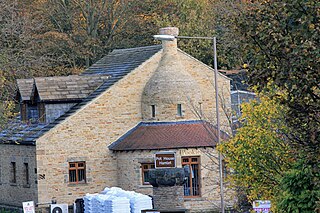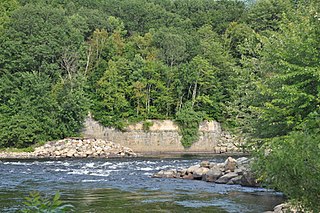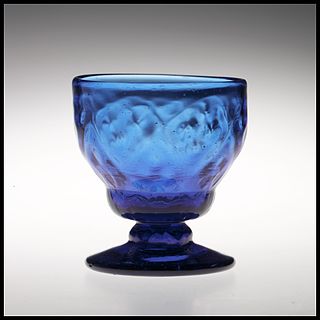
Riedel Crystal is a glassware manufacturer based in Kufstein, Austria, best known for its glassware designed to enhance different types of wines. According to Petr Novy, Chief curator Museum of Glass and Jewellery in Jablonec nad Nisou, Czech Republic, Riedel is the oldest family owned and operated global crystal glass brand worldwide. Established in Bohemia in 1756, the company is managed by Georg Riedel and Maximilian Riedel. Later, it was re-established by Claus J. Riedel in 1956, with the support of the Swarovski family.
This is a list of the National Register of Historic Places listings in Belknap County, New Hampshire.

Chance Brothers and Company was a glassworks originally based in Spon Lane, Smethwick, West Midlands, in England. It was a leading glass manufacturer and a pioneer of British glassmaking technology.

The Snead Building located at 815 W. Market St. is a multi-use facility housing two working glass studios : a Walk-In Workshop and tours by appointment.

Arc Holdings is the holding company of the Arc Group, specializing in the design and manufacturing of glass tableware. The Arc Group markets its collections in France and exports them abroad under the registered trademarks Luminarc, Arcopal, Cristal d’Arques Paris, Arcoroc and Chef&Sommelier. It also designs products for the private label and B2B markets.

Silkstone glassworks is situated at Pot House Hamlet, a historic former industrial site in Silkstone, South Yorkshire, England. A glass works was established at Silkstone around 1659 by John Pilmey, who had emigrated from France some years earlier. The glassworks had two furnaces, one for green glass and the other for white.

The Pitkin Glassworks Ruin is a historic industrial archaeological site at the junction of Parker and Putnam Streets in Manchester, Connecticut. It contains the remains of one of the oldest glass factories in New England, established in 1783. It was listed on the National Register of Historic Places in 1979.

The Catcliffe Glass Cone is a glass cone in the village of Catcliffe in South Yorkshire, England. It is the oldest surviving structure of its type in Western Europe, and it is a Grade I listed building and Scheduled Ancient Monument. Only three other glass cones survive in the United Kingdom; at Lemington, Wordsley and Alloa.
Verreville Glassworks was established on the north bank of the River Clyde in the village of Finnieston in 1777. Glass making was discontinued in 1842. The buildings of the works, including the 120 feet high glasshouse cone, were converted into a pottery works which remained in production until 1918.
Grönvik glasbruk or simply Grönvik was a glassworks in the present-day Grönvik village in Korsholm, Western Finland. It was founded by merchant Johan Grönberg and existed from 1812 to 1907. Several glass manufactures were produced at Grönvik. At first bottles and drinking-glass were made here, but beginning in the 1890s solely window glass. Also pharmaceutical glass was manufactured. The glassworks produced as the first factory in Finland pressed glass, which came about from the 1840s. The domestic market for glass was during the time of the glassworks smallish and glassblowing products were exported to e.g. Lübeck, Saint Petersburg, Stockholm and Denmark, as well as to other parts of Europe. Grönvik was able to successfully assert its position, despite the competition from other glassworks in Finland. Eventually, it became the most distinguished in the country. The glassworks also become the largest in the Nordic countries.
The Albany Glassworks Site is an archeological site in Guilderland, Albany County, New York. Approximately 2 acres (0.81 ha) in size, it was listed on the National Register of Historic Places in 1980.

The Coventry Glass Factory Historic District is a 32-acre (13 ha) historic district in Coventry, Connecticut that was listed on the National Register of Historic Places in 1987. The listing encompasses ten historically significant houses, clustered near the site of the former Coventry Glass Factory, in a linear district along what was the Boston Turnpike, now U.S. Route 44. The Skungamaug River is a creek cutting through the district. The glassworks operated here between 1813 and about 1845, and most of these houses date to that time, exhibiting largely vernacular Federal and Greek Revival styles. The most sophisticated and best-preserved house is that of Nathaniel Root, at 1044 Boston Turnpike. The ground in the area of the glassworks is littered with melted glass fragments and burnt brick fragments.
J. H. Hobbs, Brockunier and Company was one of the largest and best-known manufacturers of glass in the United States during the 19th century. Its products were distributed worldwide. The company is responsible for one of the greatest innovations in American glassmaking—an improved formula for lime glass that enabled American glass manufacturers to produce high-quality glass at a lower cost. The firm also developed talented glassmakers that started glass factories in Ohio and Indiana.

The Beaver Meadow Brook Archeological Site is a prehistoric Native American village or camp site in New Hampshire. Located near Sewall's Falls on the west bank of the Merrimack River, the site includes evidence of occupation during Middle and Late Archaic periods, as well as during the Woodland precontact period. Finds at the site include a stone axe and numerous tools for working stone, as well as projectile points and bone fragments. The site also has several hearths, evidence of significant occupation during the Woodland period.

Aquadoctan was one of the largest known Native American villages in what is now the U.S. state of New Hampshire. In an area commonly known today as The Weirs, the village lay on the north bank of the Winnipesaukee River at the outlet of Lake Winnipesaukee in the Lakes Region of New Hampshire. The site is now in Weirs Beach, a summer resort and village of the city of Laconia. The Native American village, whose archaeological remains extend for a half mile along the river and a quarter mile along the lake, has been documented through archaeological investigation to have evidence of settlement from 9,000 BCE to the late seventeenth century. Colonial reports document that the site was abandoned substantially in 1696, when most of New Hampshire's remaining native population withdrew to join the Pequawket at present-day Fryeburg, Maine.

The Lochmere Archeological District is a large archeological area on the banks of the Winnipesaukee River in Belknap County, New Hampshire, near the village of Lochmere. The area, part of which is now preserved by the state as the Brennick Lochmere Archaeological Site, is a multi-component site with evidence of human occupation from the Middle Archaic through the Late Woodland periods. The site was occupied in historic times by the Winnipesaukee sub-tribe of the Pennacook people, and is near Aquadoctan, one of the largest native towns of prehistoric New Hampshire.

Nailsea Glassworks was a glass manufacturing factory in Nailsea in the English county of Somerset. The remaining structures have been designated as a scheduled monument.

The Verrerie de Trinquetaille is a former factory of glass products, especially bottles, located in the district of Trinquetaille, in Arles, in the Bouches-du-Rhone. It is one of the few pre-industrial sites still visible in the region. The factory has produced glass jugs, such as Dame jeanne.

British industrial architecture has been created, mainly from 1700 onwards, to house industries of many kinds in Britain, home of the Industrial Revolution in this period. Both the new industrial technologies and industrial architecture soon spread worldwide. As such, the architecture of surviving industrial buildings records part of the history of the modern world.

18th century glassmaking in the United States began before the country existed. During the previous century, several attempts were made to produce glass, but none were long-lived. By 1700, it is thought that little or no glass was being produced in the British colonies that would eventually become the United States. The first American glass factory operated with long–term success was started by Caspar Wistar in 1745—although two glass works in New Amsterdam that operated in the previous century deserve honorable mention. Wistar's glass works was located in the English colony known as the Province of New Jersey. In the southeastern portion of the Province of Pennsylvania, Henry Stiegel was the first American producer of high–quality glassware known as crystal. Stiegel's first glass works began in 1763, and his better quality glassmaking began in 1769. In the United States, the first use of coal as a fuel for glassmaking furnaces is believed to have started in 1794 at a short-lived factory on the Schuylkill River near Philadelphia. In 1797 Pittsburgh's O'Hara and Craig glass works was also powered by coal, and it contributed to the eventual establishment of Pittsburgh as a leading glassmaking center in the 19th century.
















